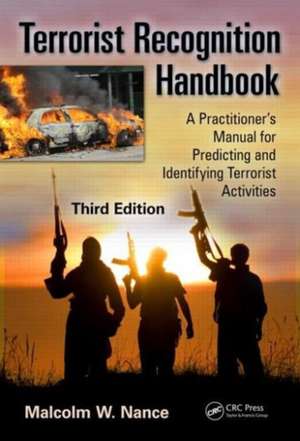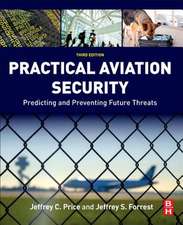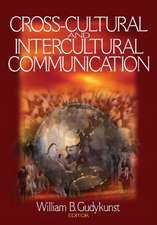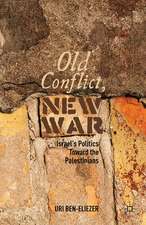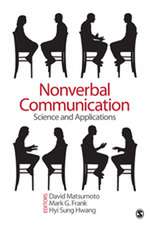Terrorist Recognition Handbook: A Practitioner's Manual for Predicting and Identifying Terrorist Activities, Third Edition
Autor Malcolm W. Nance, Desmond Wengeren Limba Engleză Paperback – 20 sep 2013
| Toate formatele și edițiile | Preț | Express |
|---|---|---|
| Paperback (1) | 505.64 lei 6-8 săpt. | |
| Taylor & Francis – 20 sep 2013 | 505.64 lei 6-8 săpt. | |
| Hardback (1) | 1042.56 lei 6-8 săpt. | |
| Taylor & Francis – 20 sep 2017 | 1042.56 lei 6-8 săpt. |
Preț: 505.64 lei
Preț vechi: 594.87 lei
-15% Nou
96.77€ • 100.65$ • 79.89£
Carte tipărită la comandă
Livrare economică 14-28 aprilie
Specificații
ISBN-10: 1466554576
Pagini: 440
Ilustrații: 149 black & white illustrations, 22 black & white tables
Dimensiuni: 178 x 254 x 28 mm
Greutate: 0.91 kg
Ediția:Revizuită
Editura: Taylor & Francis
Colecția CRC Press
Locul publicării:Oxford, United Kingdom
Public țintă
Academic and Professional Practice & DevelopmentCuprins
Recenzii
—Book review by Dr. Joshua Sinai appearing in Perspectives on Terrorism, Vol. 8, No. 1, 2014
Notă biografică
Malcolm W. Nance is a 32-year veteran of the U.S. intelligence community's combating terrorism program. He is a combat veteran who has served as a collections operator, analyst, and interrogator in Naval Intelligence and a specialist in antiterrorism and survival, evasion, resistance, and escape (SERE). He has spent 17 years deploying on antiterrorism and counterterrorism intelligence operations in the Balkans, Middle East, and sub-Saharan Africa in direct support to the principal agencies of the U.S. intelligence community. Mr. Nance has witnessed and investigated numerous terrorist incidents and participated in response operations from the two American embassy and U.S. Marine barracks bombings in Beirut, Lebanon; the TWA 847 hijacking; the Achille Lauro "marjacking;" the Libyan air raid; the first Gulf War; the War in the Balkans; the millennium bomb plot; the attack on the USS Cole; the September 11 attacks; and hundreds of suicide bombings and terrorist attacks in Iraq, Afghanistan, Libya and the Arabian Peninsula. As a master SERE instructor, Mr. Nance ran the al-Qaeda simulation group for the U.S. military's advanced terrorism, abduction, and hostage survival school from 1997 to 2001. On the morning of 9/11, he witnessed firsthand the attack on the Pentagon and became a rescuer at the crash site. In the response to the September 11 attacks. he has trained hundreds of U.S. Special Operations personnel operating in Afghanistan, Iraq, Libya, Yemen and sub-Saharan Africa in terrorism intelligence. An internationally recognized expert, author, consultant, and scholar on the al-Qaeda global terrorist organization, terror-based insurgencies, jihadist philosophy and tactics, and counter-extremist ideology and strategies he provides regular commentary for the global media including the BBC, CNN, MSNBC, FOX News, and lectures for the International Spy Museum. He lives and works between the Middle East and his home in New York.
Descriere
First published in 2003, Terrorist Recognition Handbook: A Practitioner's Manual for Predicting and Identifying Terrorist Activities remains one of the only books available to provide detailed information on terrorist methodology-revealing terrorist motivation, organizational structure, planning, financing, and operational tactics to carry out attacks. This fully revised and updated third edition contains the detailed analysis and history of prior editions with completely new case studies and information on new and emerging terrorist practices and trends. Updates to the third edition include: The newest geopolitical challenges and terrorism to emerge from the geopolitical climate post-Arab Spring Details on the newest attack tactics and procedures of al-Qaeda including al-Qaeda of the Arabian Peninsula, the Islamic Maghreb, and East and North Africa Lessons learned from recent terrorist operations and information gained from plots foiled by the FBI in the U.S.Current strategic factors and regional variables affecting global terrorism and regional insurgencies Potential points of failure in terrorist operations where plots can be most easily detected and disrupted The increasing trend of self radicalized, Internet- educated "lone wolf" operations, as demonstrated in the Boston Marathon bombing The rebirth of U.S. and European militia groups Written for counterterrorism practitioners who risk their lives to uncover planned attacks on civilian populations, this book will serve as a guide to train intelligence operatives, law enforcement entities, and military intelligence agents and soldiers to recognize and disrupt the various stages of developing terrorist plots.
